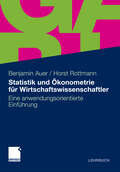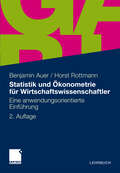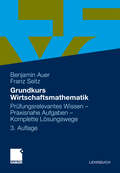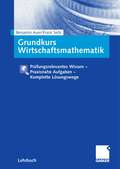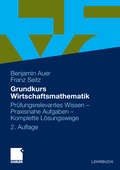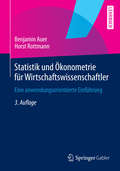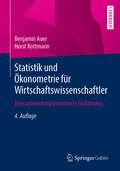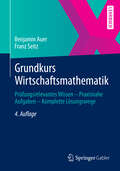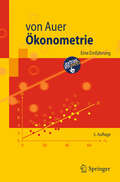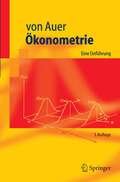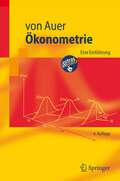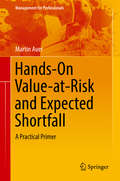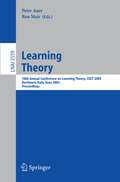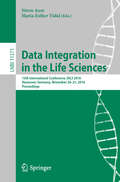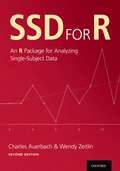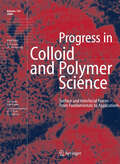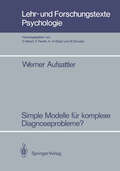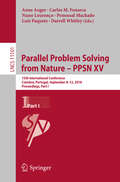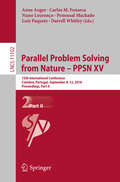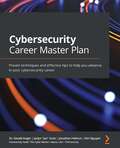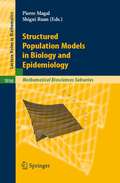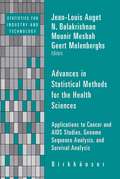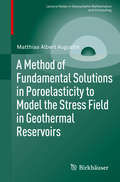- Table View
- List View
Die Gebäude der Universität Heidelberg: Textband
by B. Auer Ingeborg Klinger D. Griesbach K. Güthlein A. Krämer M. Maisant C. PrestelStatistik und Ökonometrie für Wirtschaftswissenschaftler: Eine anwendungsorientierte Einführung
by Benjamin R. Auer Horst RottmannDas Buch umfasst das gesamte für Ihr wirtschaftswissenschaftliches Studium benötigte statistische Grundwissen. Verständlich und präzise werden Ihnen unter Zuhilfenahme von Beispielen und praktischen Anwendungsfällen aus dem Finanzbereich die verschiedenen statistischen Herangehensweisen erklärt. Der hohe Praxisbezug anhand der eingearbeiteten Fallstudien zieht Sie dabei in den Bann praktischer Anwendungsmöglichkeiten für Ihren zukünftigen, beruflichen Alltag. Anhand der Praxis-Beispiele mit Musterlösungen werden Ihnen die Inhalte greifbar, mittels zahlreicher Aufgaben trainieren Sie die Anwendung des erlernten Wissens. Die geschickte Auswahl und Darstellung des Stoffs bringt Ihnen dabei das notwendige Know-how zum erfolgreichen Meistern der Klausur. Online finden Sie weiteres Übungsmaterial zur Vertiefung des Stoffs.
Statistik und Ökonometrie für Wirtschaftswissenschaftler: Eine anwendungsorientierte Einführung
by Benjamin R. Auer Horst RottmannDas Buch umfasst das gesamte für Ihr wirtschaftswissenschaftliches Studium benötigte statistische Grundwissen. Verständlich und präzise werden Ihnen unter Zuhilfenahme von Beispielen und praktischen Anwendungsfällen aus dem Finanzbereich die verschiedenen statistischen Herangehensweisen erklärt. Der hohe Praxisbezug anhand der eingearbeiteten Fallstudien zieht Sie dabei in den Bann praktischer Anwendungsmöglichkeiten für Ihren zukünftigen, beruflichen Alltag. Anhand der Praxis-Beispiele mit Musterlösungen werden Ihnen die Inhalte greifbar, mittels zahlreicher Aufgaben trainieren Sie die Anwendung des erlernten Wissens. Die geschickte Auswahl und Darstellung des Stoffs bringt Ihnen dabei das notwendige Know-how zum erfolgreichen Meistern der Klausur. Online finden Sie weiteres Übungsmaterial zur Vertiefung des Stoffs.
Grundkurs Wirtschaftsmathematik: Prüfungsrelevantes Wissen - Praxisnahe Aufgaben - Komplette Lösungswege
by Benjamin R. Auer Franz SeitzDas erste Buch zur Wirtschaftsmathematik mit kompletten Lösungswegen! Es umfasst in kompakter Weise das für ein Wirtschaftsstudium benötigte mathematische Grundwissen. Konzentriert und präzise werden die für das Grundstudium bedeutsamen Bereiche der Wirtschaftsmathematik vermittelt. Die "ausführlichen" Lösungswege machen den Stoff leicht verständlich und nachvollziehbar. D.h. über die schlichte Darstellung einer Lösung hinaus werden Ihnen auch die zum echten Verständnis der Materie notwendigen einzelnen Denkschritte gezeigt. So begreifen Sie die Funktionsweise und erfassen die Logik, die dahinter steht. Die zahlreichen Übungsaufgaben sichern Ihnen den Erfolg in der Klausur.
Grundkurs Wirtschaftsmathematik: Prüfungsrelevantes Wissen - Praxisnahe Aufgaben - Komplette Lösungswege
by Benjamin R. Auer Franz SeitzDas erste Buch zur Wirtschaftsmathematik mit kompletten Lösungswegen! Es umfasst in kompakter Weise das für ein Wirtschaftsstudium benötigte mathematische Grundwissen. Konzentriert und präzise werden die für das Grundstudium bedeutsamen Bereiche der Wirtschaftsmathematik vermittelt. Die "ausführlichen" Lösungswege machen den Stoff leicht verständlich und nachvollziehbar. D.h. über die schlichte Darstellung einer Lösung hinaus werden Ihnen die zum echten Verständnis der Materie notwendigen einzelnen Denkschritte gezeigt. Die zahlreichen Übungsaufgaben sichern Ihnen den Erfolg in der Klausur. Online finden Sie weiteres Übungsmaterial zur Vertiefung des Stoffes.
Grundkurs Wirtschaftsmathematik: Prüfungsrelevantes Wissen - Praxisnahe Aufgaben - Komplette Lösungswege
by Benjamin R. Auer Franz SeitzDas erste Buch zur Wirtschaftsmathematik mit kompletten Lösungswegen! Es umfasst in kompakter Weise das für ein Wirtschaftsstudium benötigte mathematische Grundwissen. Konzentriert und präzise werden die für das Grundstudium bedeutsamen Bereiche der Wirtschaftsmathematik vermittelt. Die "ausführlichen" Lösungswege machen den Stoff leicht verständlich und nachvollziehbar. D.h. über die schlichte Darstellung einer Lösung hinaus werden Ihnen auch die zum echten Verständnis der Materie notwendigen einzelnen Denkschritte gezeigt. So begreifen Sie die Funktionsweise und erfassen die Logik, die dahinter steht. Die zahlreichen Übungsaufgaben sichern Ihnen den Erfolg in der Klausur. Die zweite Auflage wurde, unter Berücksichtigung vieler Verbesserungsvorschläge, komplett überarbeitet und um weitere nützliche Kapitel erweitert. Online finden Sie nun neben weiterem Übungsmaterial zur Vertiefung des Stoffes auch eine Vielzahl von Excel-Tools, mit denen Sie die Inhalte des Buches einfach nachvollziehen und Beispiele rekonstruieren können.
Statistik und Ökonometrie für Wirtschaftswissenschaftler: Eine anwendungsorientierte Einführung
by Benjamin Auer Horst RottmannDas vorliegende Werk umfasst das gesamte statistische und ökonometrische Grundwissen, das für ein wirtschaftswissenschaftliches Studium benötigt wird. Verständlich und präzise werden an zahlreichen Beispielen die verschiedenen statistischen und ökonometrischen Herangehensweisen erklärt.Anhand verschiedenster Praxisfälle mit Musterlösungen und unter Einsatz der Software EViews und Excel werden die Inhalte greifbar, mittels zahlreicher Aufgaben wird die Anwendung des erlernten Wissens trainiert. Durch die geschickte Auswahl und Darstellung des Stoffs wird dabei das notwendige Know-how zum erfolgreichen Meistern empirischen Fragestellungen in Bachelor- und Masterarbeiten vermittelt. Online finden Sie weiteres Übungsmaterial zur Vertiefung des Stoffes sowie zahlreiche Excel-Tools und EViews-Workfiles. Der Ökonometrieteil der 3. Auflage wurde vollständig überarbeitet und um ein Kapitel zur Volatilitätsmodellierung (ARCH/GARCH) sowie verschiedene Aspekte der Zeitreihenanalyse (Konjunkturindikatoren, autoregressive Modellierung von Anleiherenditen) erweitert.
Statistik und Ökonometrie für Wirtschaftswissenschaftler: Eine anwendungsorientierte Einführung
by Benjamin Auer Horst RottmannDas vorliegende Werk umfasst das gesamte statistische und ökonometrische Grundwissen, das für ein wirtschaftswissenschaftliches Studium benötigt wird. Verständlich und präzise werden an zahlreichen Beispielen die verschiedenen statistischen und ökonometrischen Herangehensweisen erklärt.Anhand verschiedenster Praxisfälle mit Musterlösungen und unter Einsatz der Software EViews, STaTa und Excel werden die Inhalte greifbar, mittels zahlreicher Aufgaben wird die Anwendung des erlernten Wissens trainiert. Durch die geschickte Auswahl und Darstellung des Stoffs wird dabei das notwendige Know-how zum erfolgreichen Meistern von empirischen Fragestellungen in Bachelor- und Masterarbeiten vermittelt.Online finden Sie unter www.statistik-auer-rottmann.de weiteres Übungsmaterial zur Vertiefung des Stoffes sowie zahlreiche Excel-Tools, EViews- und STaTa-Datensätze. Der Ökonometrieteil der 4. Auflage wurde vollständig überarbeitet und um verschiedene Aspekte der ökonometrischen Theorie (z. B. strikte Exogenität) und der Zeitreihenanalyse (z. B. Beseitigung von Störtermautokorrelation durch verzögert endogene Variablen, dynamische OLS-Schätzung bei Kointegration, Mincer-Zarnowitz-Regression zur Prognosegütebeurteilung) erweitert.
Grundkurs Wirtschaftsmathematik: Prüfungsrelevantes Wissen - Praxisnahe Aufgaben - Komplette Lösungswege
by Benjamin Auer Franz SeitzDer „Grundkurs Wirtschaftsmathematik“ vermittelt in kompakter Weise das für ein Wirtschaftsstudium benötigte mathematische Grundwissen. Die ausführlichen Lösungswege machen den Stoff leicht verständlich und nachvollziehbar, d.h. über die schlichte Darstellung einer Lösung hinaus werden auch die zum echten Verständnis der Materie notwendigen einzelnen Denkschritte gezeigt. Zahlreiche Übungsaufgaben sichern eine erfolgreiche Klausurvorbereitung.
Ökonometrie: Eine Einführung (Springer-Lehrbuch)
by Ludwig AuerDieses Lehrbuch bietet eine praxisorientierte Einführung in die Methoden der Ökonometrie. Angesichts der zunehmenden Bedeutung der empirischen Analyse in Wissenschaft und Praxis will das Buch die Ökonometrie aus ihrer formal-mathematischen Ecke herausholen und einem breiteren Interessentenkreis zugänglich machen. In der Konzeption des Lehrbuches erhielt deshalb didaktisches Profil grundsätzlich Vorrang vor wissenschaftlicher Eleganz. Unterstützt durch zahlreiche Illustrationen, ausführliche verbale Erläuterungen und begleitende numerische Beispiele werden sowohl die ökonometrischen Grundlagen als auch anspruchsvollere Themenbereiche in gut verständlicher Art und Weise aufbereitet. Das Lehrbuch kommt ohne den Einsatz von Matrixalgebra aus. Ambitionierte Leser finden jedoch in den jeweiligen Kapitelanhängen ausführliche matrixalgebraische Darstellungen des behandelten Materials.
Ökonometrie: Eine Einführung (Springer-Lehrbuch)
by Ludwig AuerDieses Lehrbuch bietet eine praxisorientierte Einführung in die Methoden der Ökonometrie. Angesichts der zunehmenden Bedeutung der empirischen Analyse in Wissenschaft und Praxis will das Buch die Ökonometrie aus ihrer formal-mathematischen Ecke herausholen und einem breiteren Interessentenkreis zugänglich machen. In der Konzeption des Lehrbuches erhielt deshalb didaktisches Profil grundsätzlich Vorrang vor wissenschaftlicher Eleganz. Unterstützt durch zahlreiche Illustrationen, ausführliche verbale Erläuterungen und begleitende numerische Beispiele werden sowohl die ökonometrischen Grundlagen als auch anspruchsvollere Themenbereiche – wie beispielsweise das Fehlerkorrekturmodell – in gut verständlicher Art und Weise aufbereitet. Der Autor wurde von der Studentenschaft mit zahlreichen Preisen für hervorragende Lehre ausgezeichnet.
Ökonometrie: Eine Einführung (Springer-Lehrbuch)
by Ludwig von AuerDieses Lehrbuch bietet eine praxisorientierte Einführung in die Methoden der Ökonometrie. Angesichts der zunehmenden Bedeutung der empirischen Analyse in Wissenschaft und Praxis will das Buch die Ökonometrie aus ihrer formal-mathematischen Ecke herausholen und einem breiteren Interessentenkreis zugänglich machen. In der Konzeption des Lehrbuches erhielt deshalb didaktisches Profil grundsätzlich Vorrang vor wissenschaftlicher Eleganz. Unterstützt durch zahlreiche Illustrationen, ausführliche verbale Erläuterungen und begleitende numerische Beispiele werden sowohl die ökonometrischen Grundlagen als auch anspruchsvollere Themenbereiche in gut verständlicher Art und Weise aufbereitet. Das Lehrbuch kommt ohne den Einsatz von Matrixalgebra aus. Ambitionierte Leser finden jedoch in den jeweiligen Kapitelanhängen ausführliche matrixalgebraische Darstellungen des behandelten Materials.
Hands-On Value-at-Risk and Expected Shortfall: A Practical Primer (Management for Professionals)
by Martin AuerThis book describes a maximally simple market risk model that is still practical and main risk measures like the value-at-risk and the expected shortfall. It outlines the model's (i) underlying math, (ii) daily operation, and (iii) implementation, while stripping away statistical overhead to keep the concepts accessible. The author selects and weighs the various model features, motivating the choices under real-world constraints, and addresses the evermore important handling of regulatory requirements. The book targets not only practitioners new to the field but also experienced market risk operators by suggesting useful data analysis procedures and implementation details. It furthermore addresses market risk consumers such as managers, traders, and compliance officers by making the model behavior intuitively transparent.A very useful guide to the theoretical and practical aspects of implementing and operating a risk-monitoring system for a mid-size financial institution. It sets a common body of knowledge to facilitate communication between risk managers, computer and investment specialists by bridging their diverse backgrounds. Giovanni Barone-Adesi — Professor, Universitá della Svizzera italiana This unassuming and insightful book starts from the basics and plainly brings the reader up to speed on both theory and implementation.Shane Hegarty — Director Trade Floor Risk Management, Scotiabank Visit the book’s website at www.value-at-risk.com.
Learning Theory: 18th Annual Conference on Learning Theory, COLT 2005, Bertinoro, Italy, June 27-30, 2005, Proceedings (Lecture Notes in Computer Science #3559)
by Peter Auer Ron MeirThis volume contains papers presented at the Eighteenth Annual Conference on Learning Theory (previously known as the Conference on Computational Learning Theory) held in Bertinoro, Italy from June 27 to 30, 2005. The technical program contained 45 papers selected from 120 submissions, 3 open problems selected from among 5 contributed, and 2 invited lectures. The invited lectures were given by Sergiu Hart on “Uncoupled Dynamics and Nash Equilibrium”, and by Satinder Singh on “Rethinking State, Action, and Reward in Reinforcement Learning”. These papers were not included in this volume. The Mark Fulk Award is presented annually for the best paper co-authored by a student. The student selected this year was Hadi Salmasian for the paper titled “The Spectral Method for General Mixture Models” co-authored with Ravindran Kannan and Santosh Vempala. The number of papers submitted to COLT this year was exceptionally high. In addition to the classical COLT topics, we found an increase in the number of submissions related to novel classi?cation scenarios such as ranking. This - crease re?ects a healthy shift towards more structured classi?cation problems, which are becoming increasingly relevant to practitioners.
Data Integration in the Life Sciences: 13th International Conference, DILS 2018, Hannover, Germany, November 20-21, 2018, Proceedings (Lecture Notes in Computer Science #11371)
by Sören Auer Maria-Esther VidalThis book constitutes revised selected papers from the 13th International Conference on Data Integration in the Life Sciences, DILS 2018, held in Hannover, Germany, in November 2018.The 5 full, 8 short, 3 poster and 4 demo papers presented in this volume were carefully reviewed and selected from 22 submissions. The papers are organized in topical sections named: big biomedical data integration and management; data exploration in the life sciences; biomedical data analytics; and big biomedical applications.
SSD for R: An R Package for Analyzing Single-Subject Data
by Charles Auerbach Wendy ZeitlinSingle-subject research designs have been used to build evidence to the effective treatment of problems across various disciplines including social work, psychology, psychiatry, medicine, allied health fields, juvenile justice, and special education. SSD for R serves as a guide for those desiring to conduct single-subject data analysis and introduces readers to the various functions available in SSD for R, a new, free, and innovative software package written in R--the open-source statistical programming language that was written by the book's authors. This second edition of SSD for R is the most comprehensive guide to the numerous graphing and charting functions for conducting robust visual analysis including line graphs and more complex standard deviation lines. This book also contains numerous tests of statistical significance, such as t-tests, chi-squares, and the conservative dual criteria. Auerbach and Zeitlin guide readers through the analytical process based on the characteristics of their data. In addition to presentations and assignments, this new edition contains more examples and illustrations to help readers understand the wide range of functions available in SSD for R and their application to data analysis and interpretation. SSD for R is the only book of its kind to describe single-subject data analysis while providing free statistical software to do so. For more instructional videos, blogs, and a growing community of researchers interested in single-subject designs, visit the authors' website: http://ssdanalysis.com.
SSD for R: An R Package for Analyzing Single-Subject Data
by Charles Auerbach Wendy ZeitlinSingle-subject research designs have been used to build evidence to the effective treatment of problems across various disciplines including social work, psychology, psychiatry, medicine, allied health fields, juvenile justice, and special education. SSD for R serves as a guide for those desiring to conduct single-subject data analysis and introduces readers to the various functions available in SSD for R, a new, free, and innovative software package written in R--the open-source statistical programming language that was written by the book's authors. This second edition of SSD for R is the most comprehensive guide to the numerous graphing and charting functions for conducting robust visual analysis including line graphs and more complex standard deviation lines. This book also contains numerous tests of statistical significance, such as t-tests, chi-squares, and the conservative dual criteria. Auerbach and Zeitlin guide readers through the analytical process based on the characteristics of their data. In addition to presentations and assignments, this new edition contains more examples and illustrations to help readers understand the wide range of functions available in SSD for R and their application to data analysis and interpretation. SSD for R is the only book of its kind to describe single-subject data analysis while providing free statistical software to do so. For more instructional videos, blogs, and a growing community of researchers interested in single-subject designs, visit the authors' website: http://ssdanalysis.com.
Surface and Interfacial Forces - From Fundamentals to Applications (Progress in Colloid and Polymer Science #134)
by Günter Auernhammer Hans-Jürgen Butt Doris Vollmer© Springer-Verlag 2008 rd 43 Biennial Meeting of the German Colloid Society rd This volume containsselected paperspresented at the 43 Biennial Meeting of the German Colloid Society held at the Schloß Waldthausen near Mainz, October 8–10, 2007. The meeting’s emphasis was given to “Surface and Interfacial Forces – From Fundamentals to Applications” but also provided a general overview on current aspects of colloid and polymer science in fundamental research and applications. The contributions in this volume are representative of the richness of research topics in colloid and polymer science. They cover a broad eld including the application of scanning probe techniques to colloid and interface science, surface induced ordering, novel developments in amphiphilic systems as well as the synthesis and applications of nano-colloids. The meeting brought together people from different elds of colloid, polymer, and materials science and provided the platform for dialogue between scientists from universities, industry, and research institutions.
Simple Modelle für komplexe Diagnoseprobleme?: Zur Robustheit probabilistischer Diagnoseverfahren gegenüber vereinfachenden Modellannahmen (Lehr- und Forschungstexte Psychologie #21)
by Werner AufsattlerParallel Problem Solving from Nature – PPSN XV: 15th International Conference, Coimbra, Portugal, September 8–12, 2018, Proceedings, Part I (Lecture Notes in Computer Science #11101)
by Anne Auger Carlos M. Fonseca Nuno Lourenço Penousal Machado Luís Paquete Darrell WhitleyThis two-volume set LNCS 11101 and 11102 constitutes the refereed proceedings of the 15th International Conference on Parallel Problem Solving from Nature, PPSN 2018, held in Coimbra, Portugal, in September 2018. The 79 revised full papers were carefully reviewed and selected from 205 submissions. The papers cover a wide range of topics in natural computing including evolutionary computation, artificial neural networks, artificial life, swarm intelligence, artificial immune systems, self-organizing systems, emergent behavior, molecular computing, evolutionary robotics, evolvable hardware, parallel implementations and applications to real-world problems. The papers are organized in the following topical sections: numerical optimization; combinatorial optimization; genetic programming; multi-objective optimization; parallel and distributed frameworks; runtime analysis and approximation results; fitness landscape modeling and analysis; algorithm configuration, selection, and benchmarking; machine learning and evolutionary algorithms; and applications. Also included are the descriptions of 23 tutorials and 6 workshops which took place in the framework of PPSN XV.
Parallel Problem Solving from Nature – PPSN XV: 15th International Conference, Coimbra, Portugal, September 8–12, 2018, Proceedings, Part II (Lecture Notes in Computer Science #11102)
by Anne Auger Carlos M. Fonseca Nuno Lourenço Penousal Machado Luís Paquete Darrell WhitleyThis two-volume set LNCS 11101 and 11102 constitutes the refereed proceedings of the 15th International Conference on Parallel Problem Solving from Nature, PPSN 2018, held in Coimbra, Portugal, in September 2018. The 79 revised full papers were carefully reviewed and selected from 205 submissions. The papers cover a wide range of topics in natural computing including evolutionary computation, artificial neural networks, artificial life, swarm intelligence, artificial immune systems, self-organizing systems, emergent behavior, molecular computing, evolutionary robotics, evolvable hardware, parallel implementations and applications to real-world problems. The papers are organized in the following topical sections: numerical optimization; combinatorial optimization; genetic programming; multi-objective optimization; parallel and distributed frameworks; runtime analysis and approximation results; fitness landscape modeling and analysis; algorithm configuration, selection, and benchmarking; machine learning and evolutionary algorithms; and applications. Also included are the descriptions of 23 tutorials and 6 workshops which took place in the framework of PPSN XV.
Cybersecurity Career Master Plan (PDF): Proven Techniques And Effective Tips To Help You Advance In Your Cybersecurity Career
by Gerald Auger Jaclyn Scott Jonathan Helmus Kim NguyenGet started with cybersecurity and progress with the help of expert tips to get certified, find a job, and more Key Features Learn how to follow your desired career path that results in a well-paid, rewarding job in cybersecurity Explore expert tips relating to career paths and certification options Access informative content from a panel of experienced cybersecurity experts Book Description Cybersecurity is an emerging career trend and will continue to become increasingly important. Despite the lucrative pay and significant career growth opportunities, many people are unsure of how to get started. This book is designed by leading industry experts to help you enter the world of cybersecurity with confidence, covering everything from gaining the right certification to tips and tools for finding your first job. The book starts by helping you gain a foundational understanding of cybersecurity, covering cyber law, cyber policy, and frameworks. Next, you'll focus on how to choose the career field best suited to you from options such as security operations, penetration testing, and risk analysis. The book also guides you through the different certification options as well as the pros and cons of a formal college education versus formal certificate courses. Later, you'll discover the importance of defining and understanding your brand. Finally, you'll get up to speed with different career paths and learning opportunities. By the end of this cyber book, you will have gained the knowledge you need to clearly define your career path and develop goals relating to career progression. What you will learn Gain an understanding of cybersecurity essentials, including the different frameworks and laws, and specialties Find out how to land your first job in the cybersecurity industry Understand the difference between college education and certificate courses Build goals and timelines to encourage a work/life balance while delivering value in your job Understand the different types of cybersecurity jobs available and what it means to be entry-level Build affordable, practical labs to develop your technical skills Discover how to set goals and maintain momentum after landing your first cybersecurity job Who this book is for This book is for college graduates, military veterans transitioning from active service, individuals looking to make a mid-career switch, and aspiring IT professionals. Anyone who considers cybersecurity as a potential career field but feels intimidated, overwhelmed, or unsure of where to get started will also find this book useful.
Structured Population Models in Biology and Epidemiology (Lecture Notes in Mathematics #1936)
by P. Auger M. Ballyk R. Bravo de la Parra W. E. Fitzgibbon S. A. Gourley D. Jones M. Langlais R. Liu M. Martcheva T. Nguyen-Huu J. C. Poggiale E. Sánchez H. L. Smith H. R. Thieme G. F. Webb J. WuIn this new century mankind faces ever more challenging environmental and publichealthproblems,suchaspollution,invasionbyexoticspecies,theem- gence of new diseases or the emergence of diseases into new regions (West Nile virus,SARS,Anthrax,etc.),andtheresurgenceofexistingdiseases(in?uenza, malaria, TB, HIV/AIDS, etc.). Mathematical models have been successfully used to study many biological, epidemiological and medical problems, and nonlinear and complex dynamics have been observed in all of those contexts. Mathematical studies have helped us not only to better understand these problems but also to ?nd solutions in some cases, such as the prediction and control of SARS outbreaks, understanding HIV infection, and the investi- tion of antibiotic-resistant infections in hospitals. Structuredpopulationmodelsdistinguishindividualsfromoneanother- cording to characteristics such as age, size, location, status, and movement, to determine the birth, growth and death rates, interaction with each other and with environment, infectivity, etc. The goal of structured population models is to understand how these characteristics a?ect the dynamics of these models and thus the outcomes and consequences of the biological and epidemiolo- cal processes. There is a very large and growing body of literature on these topics. This book deals with the recent and important advances in the study of structured population models in biology and epidemiology. There are six chapters in this book, written by leading researchers in these areas.
Advances in Statistical Methods for the Health Sciences: Applications to Cancer and AIDS Studies, Genome Sequence Analysis, and Survival Analysis (Statistics for Industry and Technology)
by Jean-Louis Auget N. Balakrishnan Mounir Mesbah Geert MolenberghsStatistical methods have become an increasingly important and integral part of research in the health sciences. Many sophisticated methodologies have been developed for specific applications and problems. This self-contained comprehensive volume covers a wide range of topics pertaining to new statistical methods in the health sciences, including epidemiology, pharmacovigilance, quality of life, survival analysis, and genomics. The book will serve the health science community as well as practitioners, researchers, and graduate students in applied probability, statistics, and biostatistics.
A Method of Fundamental Solutions in Poroelasticity to Model the Stress Field in Geothermal Reservoirs (Lecture Notes in Geosystems Mathematics and Computing)
by Matthias Albert AugustinThis monograph focuses on the numerical methods needed in the context of developing a reliable simulation tool to promote the use of renewable energy. One very promising source of energy is the heat stored in the Earth’s crust, which is harnessed by so-called geothermal facilities. Scientists from fields like geology, geo-engineering, geophysics and especially geomathematics are called upon to help make geothermics a reliable and safe energy production method. One of the challenges they face involves modeling the mechanical stresses at work in a reservoir.The aim of this thesis is to develop a numerical solution scheme by means of which the fluid pressure and rock stresses in a geothermal reservoir can be determined prior to well drilling and during production. For this purpose, the method should (i) include poroelastic effects, (ii) provide a means of including thermoelastic effects, (iii) be inexpensive in terms of memory and computational power, and (iv) be flexible with regard to the locations of data points.After introducing the basic equations and their relations to more familiar ones (the heat equation, Stokes equations, Cauchy-Navier equation), the “method of fundamental solutions” and its potential value concerning our task are discussed. Based on the properties of the fundamental solutions, theoretical results are established and numerical examples of stress field simulations are presented to assess the method’s performance. The first-ever 3D graphics calculated for these topics, which neither requiring meshing of the domain nor involving a time-stepping scheme, make this a pioneering volume.

